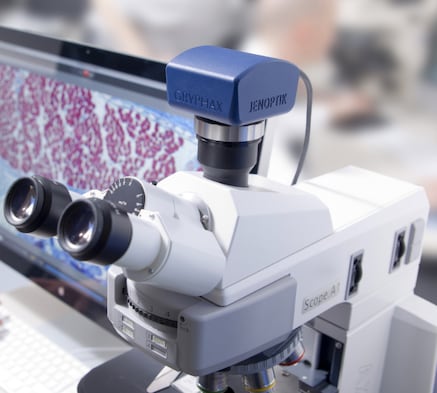RecommendMail Facebook LinkedIn
- Health & Science
- Digitization
Genuine leather or imitation? In pursuit of quality with microscopy
Opinions and standards regarding the authenticity and naturalness of the material leather occasionally differ, particularly as the result of a globalized and increasingly online-driven trade. This is where the identification of genuine leather can help to dispel any misunderstandings between manufacturers, retailers, purchasing companies and, not least, the consumers.
, Stefan SeidleinLeather analysis using microscopy and the evaluation of its authenticity on this basis enable quality assurance and the correct labeling of a leather product in accordance with the local consumer protection directives.
If importers want certainty that they are dealing with a "genuine product", which is really worth its price, they commission an appraiser, such as Frank Recht, to analyze a sample to identify whether it is genuine leather. Frank Recht is an appraiser and expert specialized in the field of leather. An essential part of his work is the expert identification of genuine leather, above all for fine leather goods in fashion segments such as clothing, belts, handbags, watch straps or technical accessories like mobile phone and tablet covers. The sample is examined on the basis of numerous DIN and RAL standards and an expert report is then prepared. Product safety issues, such as identifying whether chromium VI or other harmful substances are contained in the imported goods can also be addressed, using an appropriate analysis.
We met up with Frank Recht and were able to ask him a few questions about his work, in which Jenoptik also plays an important role. He creates, for example, microscopic images of leather samples using his stereo microscope and an ARKTUR microscope camera from the JENOPTIK GRYPHAX® series to identify whether they are genuine leather or not.
Mr. Recht, a consumer might think it would be pretty easy to differentiate between genuine and non-genuine leather just using human sensory perception. But it's probably not that easy, is it?
It is actually becoming more and more difficult. The surfaces of imitation leather or leather alternatives have improved to such an extent that it is now no longer possible to tell if a product is made of genuine leather or not simply by looking at it. In the meantime, even the characteristic grain patterns of ostrich or crocodile leather are imitated, over and above the standard cowhide look. The result is astonishingly good and looks very similar to genuine leather.
You use microscopy to identify whether or not a product is made of genuine leather. Could you briefly explain what these images that you took with your ARKTUR microscope camera from the JENOPTIK GRYPHAX® series show?
We can see here a detail of a belt cross-section that is 4.82 mm thick. The width of the belt is 4 cm. The thickness of the layer and the texture provide information about how to categorize the leather. The two outer layers in this picture, that is layer 1 and 4 of this image, are artificial leather. In layer 2 we can identify a leather fiber and in layer 3 so-called split leather.
Microscopy is essential for you to identify whether genuine leather or imitation leather is presented. What specific equipment do you use for identifying genuine leather?
I mostly use a stereo microscope. When measuring the thickness of the top layer, I sometimes use a compact laboratory microscope with magnifications of 5 - 10 - 20 - 50 - 100 due to the resolution. I operate the ARKTUR microscope camera from the JENOPTIK GRYPHAX® series on a MAC mini with a 4K monitor. The supplied JENOPTIK GRYPHAX® software perfectly meets all my requirements for my daily work in determining whether a product is genuine leather; above all, it is user-friendly.
What was important to you when choosing a suitable microscope camera to identify genuine leather?

It definitely needed to be MAC-compatible and, of course, image quality is of the utmost importance in the area of expert appraisals. High contrast, a very good image performance and good depth of field were very important to me.
Mr. Recht, thank you very much for sharing with us these interesting insights into identifying genuine leather using microscopy.
If you too would like to know how you can make concealed objects visible with brilliant images and unveil quality, then simply get in contact with us. Our JENOPTIK GRYPHAX® microscope cameras are loyal companions for microscopy tasks in a wide range of applications – not only for quality assurance but also in sectors such as healthcare and life science or education.
*Images kindly provided by the appraiser bureau Frank Recht.
Product recommendation
About Stefan Seidlein
Stefan Seidlein has been working for Jenoptik since 2000 in various positions in the field of Digital Imaging. As product manager, he currently focuses on the light microscope camera product portfolio and brings his entire digital imaging competence and experience to projects. As a graduated technician with a focus on energy technology and process automation, he is fascinated by digitalization and the many opportunities it offers both individuals and Jenoptik.











